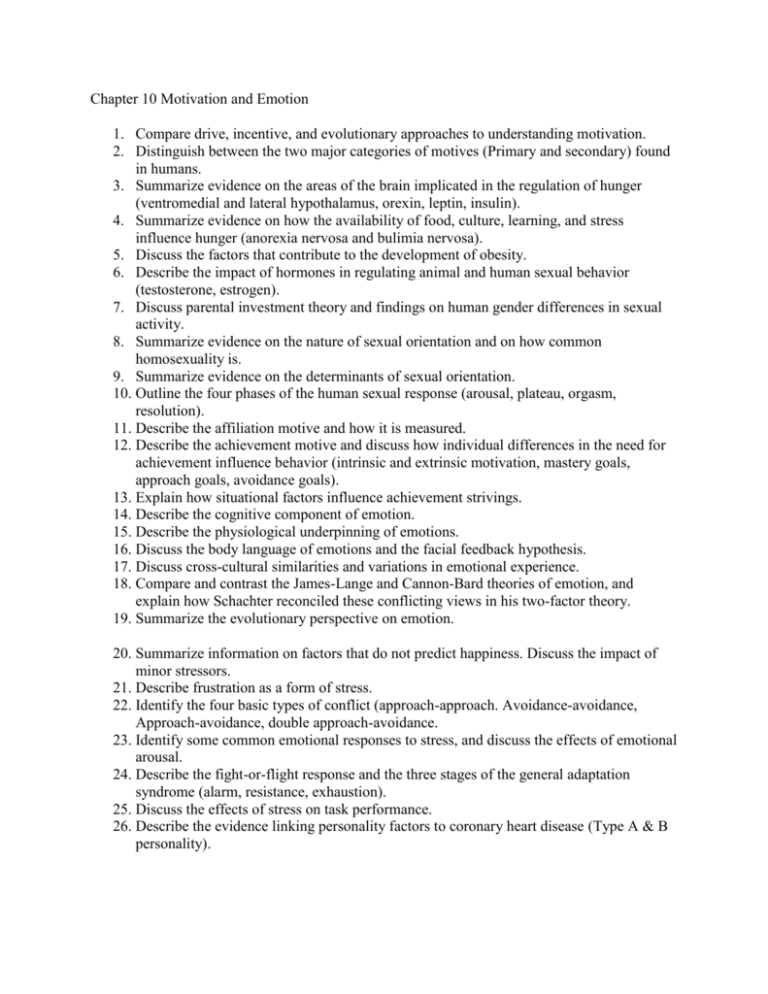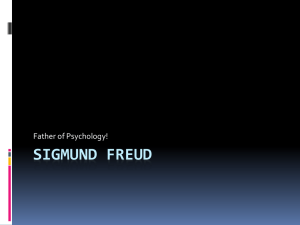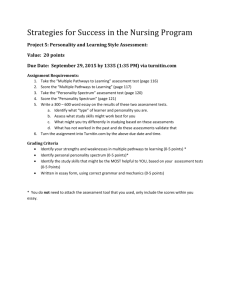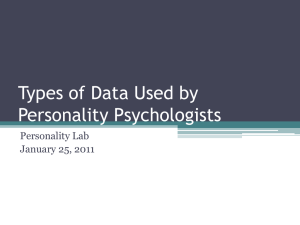Chapter 10-12 study guide
advertisement

Chapter 10 Motivation and Emotion 1. Compare drive, incentive, and evolutionary approaches to understanding motivation. 2. Distinguish between the two major categories of motives (Primary and secondary) found in humans. 3. Summarize evidence on the areas of the brain implicated in the regulation of hunger (ventromedial and lateral hypothalamus, orexin, leptin, insulin). 4. Summarize evidence on how the availability of food, culture, learning, and stress influence hunger (anorexia nervosa and bulimia nervosa). 5. Discuss the factors that contribute to the development of obesity. 6. Describe the impact of hormones in regulating animal and human sexual behavior (testosterone, estrogen). 7. Discuss parental investment theory and findings on human gender differences in sexual activity. 8. Summarize evidence on the nature of sexual orientation and on how common homosexuality is. 9. Summarize evidence on the determinants of sexual orientation. 10. Outline the four phases of the human sexual response (arousal, plateau, orgasm, resolution). 11. Describe the affiliation motive and how it is measured. 12. Describe the achievement motive and discuss how individual differences in the need for achievement influence behavior (intrinsic and extrinsic motivation, mastery goals, approach goals, avoidance goals). 13. Explain how situational factors influence achievement strivings. 14. Describe the cognitive component of emotion. 15. Describe the physiological underpinning of emotions. 16. Discuss the body language of emotions and the facial feedback hypothesis. 17. Discuss cross-cultural similarities and variations in emotional experience. 18. Compare and contrast the James-Lange and Cannon-Bard theories of emotion, and explain how Schachter reconciled these conflicting views in his two-factor theory. 19. Summarize the evolutionary perspective on emotion. 20. Summarize information on factors that do not predict happiness. Discuss the impact of minor stressors. 21. Describe frustration as a form of stress. 22. Identify the four basic types of conflict (approach-approach. Avoidance-avoidance, Approach-avoidance, double approach-avoidance. 23. Identify some common emotional responses to stress, and discuss the effects of emotional arousal. 24. Describe the fight-or-flight response and the three stages of the general adaptation syndrome (alarm, resistance, exhaustion). 25. Discuss the effects of stress on task performance. 26. Describe the evidence linking personality factors to coronary heart disease (Type A & B personality). Chapter 12 1. Define the construct of personality in terms of consistency and distinctiveness. 2. Explain what is meant by a personality trait and describe the five-factor model of personality. 3. List and describe the three components into which Freud divided the personality, and indicate how these are distributed across three levels of awareness (Id, Ego, Superego, conscious, preconscious, unconscious). 4. Explain the preeminence of sexual and aggressive conflicts in Freud’s theory, and describe the operation of defense mechanisms. 5. Outline Freud’s psychosexual stages of development and their theorized relations to adult personality. 6. Summarize the revisions of Freud’s theory proposed by Jung, Horney, and Adler. 7. Summarize the strengths and weaknesses of the psychodynamic approach to personality. 8. Discuss how Skinner’s principles of operant conditioning can be applied to the structure and development of personality. 9. Describe Bandura’s social cognitive theory (cognitive dissonance, reciprocal determinism). 10. Summarize the strengths and weaknesses of the behavioral approach to personality. 11. Explain how humanism was a reaction against both the behavioral and psychodynamic approaches, and discuss the assumptions of the humanistic view. 12. Identify Rogers’ person-centered theory of personality development. 13. Explain Maslow’s hierarchy of needs and summarize his findings on the characteristics of self-actualizing people. 14. Describe Eysenck’s theory of personality. 15. Outline Buss’ explanation for why the Big Five traits are important. 16. Discuss the meaning of sensation seeking, and identify the characteristics of high sensation seekers. 17. Explain what is meant by self-monitoring, and identify the characteristics of those high in self-monitoring. 18. Outline the four principal uses of personality tests. 19. Describe the MMPI, 16PF, and NEO Personality Inventory, and summarize the strengths and weaknesses of self-report inventories. 20. Describe the projective hypothesis, and summarize the strengths and weaknesses of projective tests. 21. Discuss how hindsight bias affects personality.









